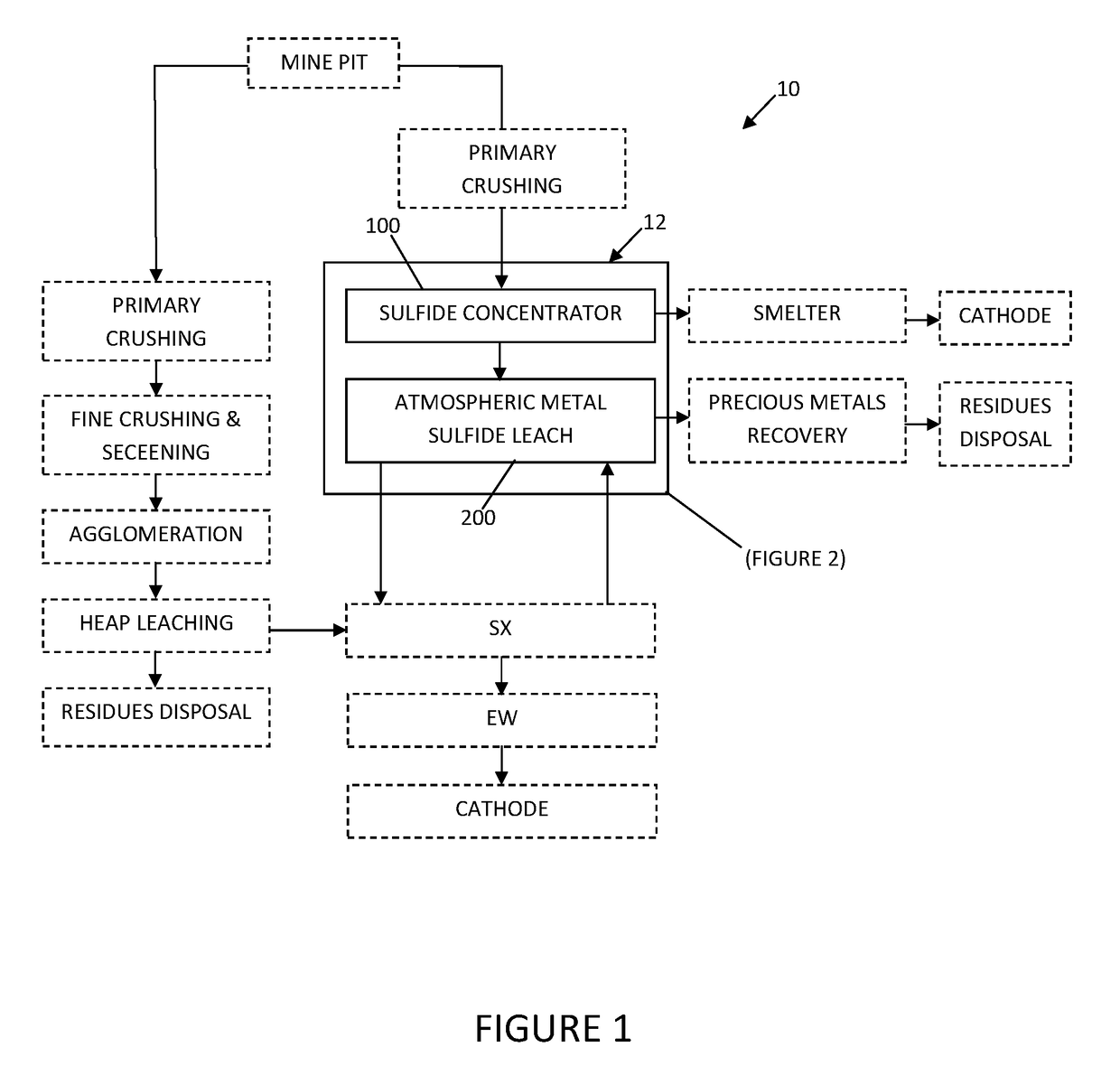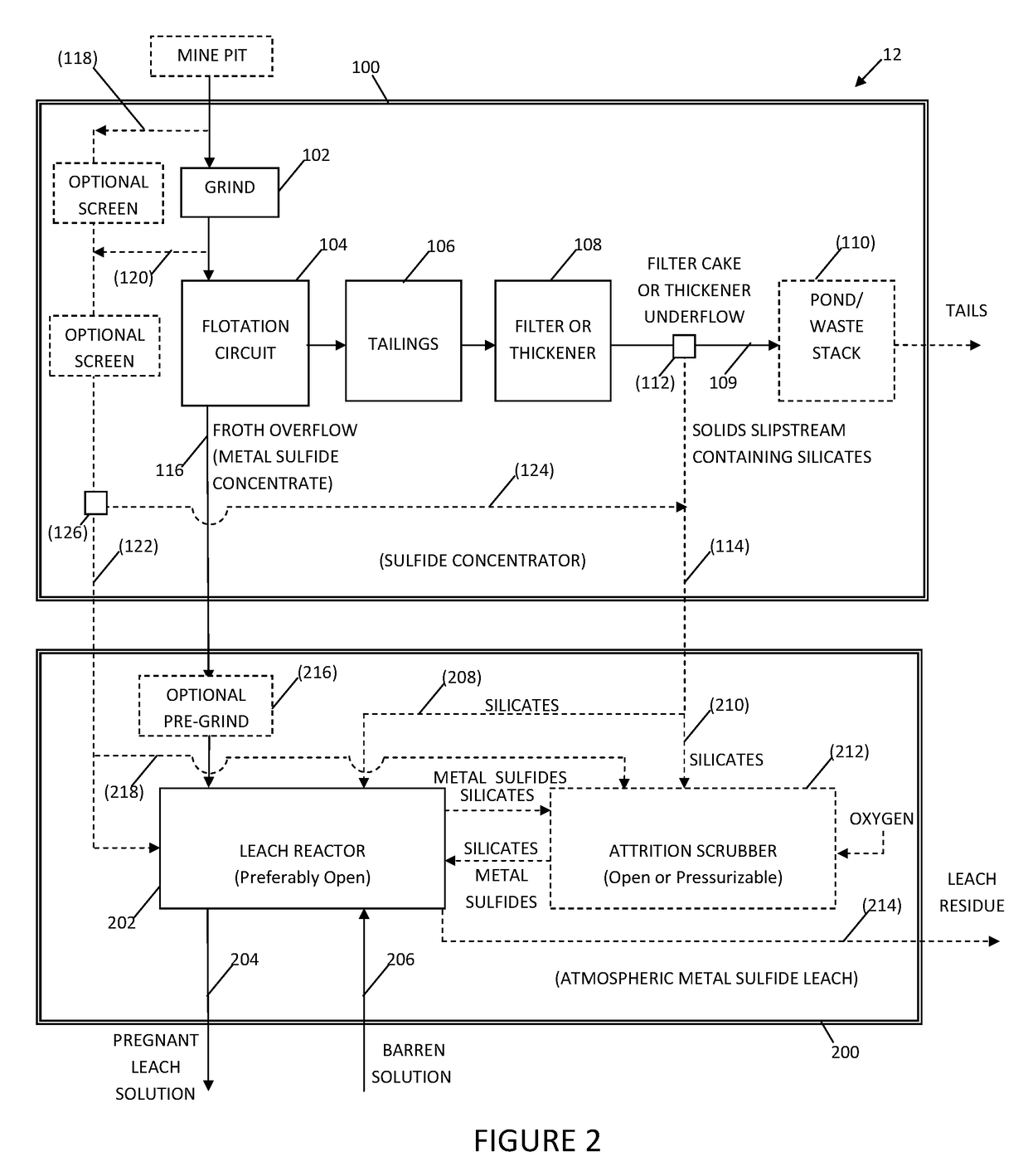System and method for controlling frothing during atmospheric leaching of metal sulphides using silicates
a technology of atmospheric leaching and silicates, applied in the direction of solid separation, process efficiency improvement, flotation, etc., can solve the problems of reducing the actual leach residence time of floated particles contained within the froth, reducing the overall leach recovery, and limiting the effect of atmospheric metal sulfide leaching
- Summary
- Abstract
- Description
- Claims
- Application Information
AI Technical Summary
Benefits of technology
Problems solved by technology
Method used
Image
Examples
example 1
[0047]A preliminary, experimental test of the effect of recycling silicates for the benefit of reducing frothing and improving leach kinetics and copper recovery during the acid ferric sulfate leaching of chalcopyrite was conducted. The leach tests were conducted at 80° C. under atmospheric pressure. The results of the test are shown in FIG. 5. For the purposes of illustration only, the silicates used in the leach tests were flotation rougher tailings. The rougher tailings material was comprised primarily of pyrite, orthoclase, muscovite, quartz, and albite. This is considered an extreme test of the inventive concept, as the material, by virtue of being a flotation tailings product, would contain residual amounts of flotation reagents (i.e., froth promoting agents) which could possibly hamper leaching. Those skilled in the art will appreciate from the appended drawings and this disclosure, that the silicates could have been alternatively or additionally obtained as a slip stream fro...
example 2
[0049]A comparative test was conducted in which there was no addition of silicates to the leach feed. The leach data associated with no addition of silicates is depicted by the (Δ) symbols in FIG. 5. The P95 particle size distribution of the chalcopyrite concentrate was 35 μm and the test was conducted at 7.5 wt. % suspended solids. The addition of oxygen during the leach process resulted in the production of a large amount of highly mineralized, stable froth within the leach reactor. This resulted in the transfer of a significant amount of solids from the leach liquor to the froth, with the consequence of limiting the copper recovery to between 90-95% at 6 hours (e.g., ˜94% at 6 hours as shown on the graph of FIG. 5).
[0050]Comparison of the comparative reference test data with the enabled results represented by the (∘) symbols shows that the addition the silicates to the leach system increased the copper leach rate significantly (i.e. the initial copper leach rate was approximately...
example 3
[0051]A third copper leach test was conducted under identical conditions to the test outlined in Example 2, except that the chalcopyrite concentrate had a P95 of 104 μm. Again, frothing was significantly reduced in relation to the comparative test, and 100% copper recovery was achieved within 6 hours. The reduced frothing meant that the oxygen flow to the reactor could be continuously maintained at a higher rate with the result that the initial copper leach rate was approximately 1.98 times faster than the comparative example.
[0052]It should be known that the particular features, processes, and benefits which are shown and described herein in detail are purely exemplary in nature and should not limit the scope of the invention. Although the invention has been described in terms of particular embodiments and applications, one of ordinary skill in the art, in light of this teaching, can generate additional embodiments and modifications without departing from the spirit of or exceeding...
PUM
| Property | Measurement | Unit |
|---|---|---|
| time | aaaaa | aaaaa |
| time | aaaaa | aaaaa |
| time | aaaaa | aaaaa |
Abstract
Description
Claims
Application Information
 Login to View More
Login to View More - R&D
- Intellectual Property
- Life Sciences
- Materials
- Tech Scout
- Unparalleled Data Quality
- Higher Quality Content
- 60% Fewer Hallucinations
Browse by: Latest US Patents, China's latest patents, Technical Efficacy Thesaurus, Application Domain, Technology Topic, Popular Technical Reports.
© 2025 PatSnap. All rights reserved.Legal|Privacy policy|Modern Slavery Act Transparency Statement|Sitemap|About US| Contact US: help@patsnap.com



